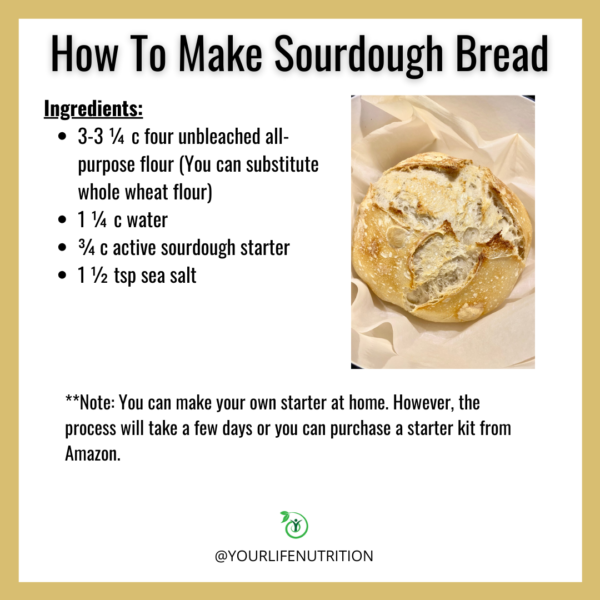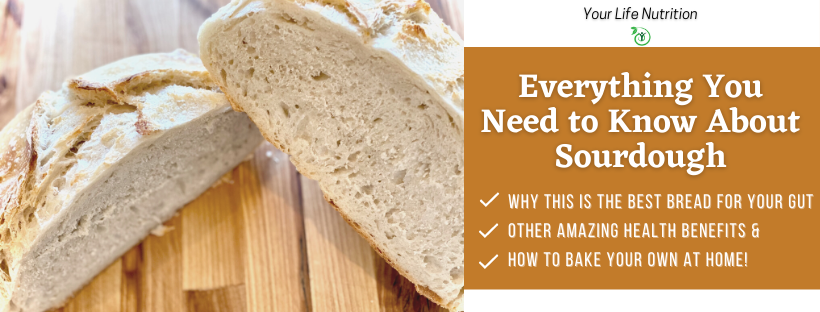What Is Sourdough Bread?
There are many types of breads produced worldwide and bread has become a staple food in most cultures. Breads are typically made from flour, water, and other ingredients. There are three typical leavening agents used when making bread, which include: chemicals, bakers yeast, and sourdough starter (1). Standard bread uses a rapid yeast-only fermentation process whereas sourdough bread utilizes bacteria and yeast to create a more natural product. Sourdough uses a starter culture made of lactic acid bacteria (LAB), flour, wild yeast, and water and is set to ferment naturally (2).

Did You Know Not All Sourdough Is Real?
There is no legal definition of sourdough bread, so some companies may sell products that are not actually sourdough bread (3). Some of these fake sourdough breads include ingredients like added yeast, ascorbic acid, vinegar, and oil. Some great ways to spot the fakes is by reading the ingredient list. In real sourdough bread you should only see flour, water, salt, and a starter culture. Another way to determine if it’s real is by looking for sweeteners because real sourdough bread does not require sugar or sweeteners to activate the yeast for the fermentation process. Lastly, you can look at the expiration date to determine if it’s real sourdough bread. Real sourdough is made with real ingredients in a natural way so it doesn’t have a long shelf life. So, if you see an expiration date that is weeks or months away, you can determine that this is not real sourdough bread (3). If you want to find real sourdough bread you will want to look at your local bakeries, specialty shops, or farmers markets. Most of the big chain stores and supermarkets do not invest the skills into making the authentic bread (3).
How Is It Fermented?
The fermentation process utilizes wild yeast, which is bacteria that is literally floating in the air and LAB to raise the dough. LAB is something that is found in many fermented foods like pickles, yogurt, kefir, and sauerkraut. The lactic acid, wild yeast, flour, and water is called the “starter”, which ferments the sugars in the dough (4). The use of LAB for the fermentation process is a natural and effective way to improve the functional and nutritional value of the product (5). LAB in sourdough bread decreases the pH of the bread which allows for breakdown of phytates. Phytates or phytic acid can inhibit the absorption of some minerals because it binds to them, ultimately reducing the bodies ability to absorb them. The decreased phytate level allows the bread to become more nutritious because it increases the absorption of minerals (4).


Nutrient Content:
Sourdough is said to be more nutritious compared to other types of bread because it is less processed. The nutrient content can vary depending on the type of flour used.
For example, according to healthline.com a 2 ounce slice of sourdough bread provides:
-162 calories
-32 grams of carbs
-2-4 grams of fiber
-6 grams of protein
Sourdough contains a good source of some minerals such as potassium, phosphate, magnesium, and zinc (4). As for the taste of sourdough bread it has a unique tangy taste (6).
Health Benefits
- Easy To Digest
- During the process of making sourdough bread, carbohydrates are broken down by the bacteria used for fermentation. This creates beneficial effects on the gastrointestinal tract. For example, this allows the bread to be tolerated by people with stomach and intestinal issues (such as irritable bowel syndrome)(2).
- When sourdough is added to the diet it can reduce abdominal discomfort, bloating, and nausea when compared to brewer’s yeast products (2).
- The activity from the LAB decreases the gluten content during the fermentation process. The longer the LAB can sit the less gluten content will be found in the bread (4). This makes this type of product safe for people with celiac disease or gluten intolerance (5).
- Studies suggest that sourdough bread acts as a prebiotic. This means that the fiber found in this bread feeds the “good” bacteria in the intestines. So, adding sourdough bread may help promote a healthy gut and ease digestion (7).
- Low Glycemic Index
- The fermentation process for sourdough bread allows for the breakdown of sugars and starches which lowers its glycemic index. Glycemic index is the number associated with foods to measure how the carbohydrate content in them affect blood sugar levels (6).
- This means that sourdough bread will give a steady blood sugar after eating a slice instead of a huge spike (6).
- Studies have been done comparing the effects of sourdough bread and breads made with bakers yeast and results show that people who ate sourdough had lower blood sugar and insulin levels after eating (4).
- Heart Health
- Studies show that sourdough and the bacteria used have properties that can prevent high blood pressure and lower cholesterol (2).
- The fermentation process increases free amino acids concentrations, which decreases the need for added salt. This is significant because cereal derived products are a huge source of salt in the typical western diet. The increased consumption of salt is associated with increased risk of heart related diseases (5).
- Compounds are created that decrease the risk of high blood pressure. For example, it may produce an amino acid that is associated with decreased blood pressure in people with moderately high blood pressure by 10-12 mg/day (5).
- Disease Prevention
- The fermentation process for sourdough increases the antioxidant activity due to the production of antioxidant compounds, which protect cells (5).
- Increased antioxidant activity decreases the risk of cancer, neurological diseases, and heart disease (7).
Ways to Incorporate Sourdough Into Your Diet (8)

- Sandwiches
- Avocado Toast
- Top it with nut butter & fruit
- Dip a slice in olive oil & herbs
- Use it when making stuffing
- Have on the side with soup
- Make them into bread crumbs
- Top with bruschetta
Here’s a great recipe for making your own bread!
Check out these step-by-step videos of how to make your own Sourdough Bread.





Adaptation from: Simple Life By Kels
Post Written & Created by: Your Life Nutrition Intern, Vincent Ray – Senior at The University of Akron, majoring in Dietetics.
References:
- Rizzello CG, Portincasa P, Montemurro M, et al. Sourdough Fermented Breads are More Digestible than Those Started with Baker’s Yeast Alone: An In Vivo Challenge Dissecting Distinct Gastrointestinal Responses. Nutrients. 2019;11(12):2954. Published 2019 Dec 4. doi:10.3390/nu11122954
- Dimidi E, Cox SR, Rossi M, Whelan K. Fermented Foods: Definitions and Characteristics, Impact on the Gut Microbiota and Effects on Gastrointestinal Health and Disease. Nutrients. 2019;11(8):1806. Published 2019 Aug 5. doi:10.3390/nu11081806
- Kay S. How to Spot a Fake Sourdough. Stephanie Kay | Nutritionist & Speaker. https://kaynutrition.com/how-to-spot-a-fake-sourdough/. Published December 26, 2018. Accessed March 28, 2021.
- Petre A. Why Sourdough Bread Is One of the Healthiest Breads. Healthline. https://www.healthline.com/nutrition/sourdough-bread. Published February 28, 2017. Accessed March 17, 2021.
- Montemurro M, Coda R, Rizzello CG. Recent Advances in the Use of Sourdough Biotechnology in Pasta Making. Foods. 2019;8(4):129. Published 2019 Apr 18. doi:10.3390/foods8040129
- Prakash S. 7 Facts You Need to Know About Sourdough Bread. Clean Plates. https://cleanplates.com/nutrition/is-sourdough-healthy/?utm_source=postup&utm_medium=email&utm_campaign=20210118. Published January 13, 2021. Accessed March 17, 2021.
- Brennan D. Sourdough Bread: Is It Good for You? Pros and Cons, Nutrition Information, and More. WebMD. https://www.webmd.com/diet/sourdough-bread-good-for-you#2. Published September 29, 2020. Accessed March 17, 2021.
- Fix Editors Updated July 22. Everything You Ever Wanted to Know About Sourdough Bread. Food & Wine. https://www.foodandwine.com/news/how-make-sourdough-bread. Published July 22, 2016. Accessed March 17, 2021.






[…] Previous Sourdough Bread […]